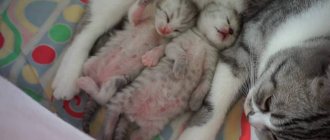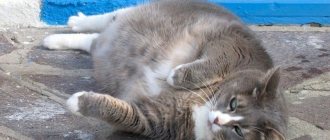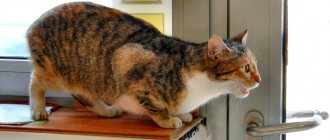If the owners are lucky enough to have a cat, then it is extremely important for its health that the pet at least once acquires kittens. There is a category of owners who prefer to decide their pet’s fate and resort to sterilization. But if a pet is still expecting a new addition, it is extremely important for owners to prepare for this event and have sufficient information on this issue.
Unlike humans, cat pregnancy has its own characteristics: you need to understand what signs to recognize pregnancy in cats - how many kittens to expect, how to prepare your pet, how long pregnancy lasts in cats, how to provide care after lambing, and much more.
Signs of pregnancy in cats
So, how to recognize that an animal is expecting offspring? The first signs may be a change in the pet’s behavior: the cat becomes very affectionate, demands increased attention, caresses and is happy to be held. Depending on how long a cat is pregnant, her taste preferences also change: during the first weeks she may eat even less than usual, but by the third week her appetite increases. Among the physiological symptoms, it should be noted the absence of another estrus, swelling of the nipples and a change in their color.
You can reliably determine how long a cat is pregnant and how many kittens a cat is carrying by having an ultrasound done in a specialized veterinary clinic. Such a study is considered quite reliable, starting from the fifteenth day of pregnancy. In addition, there is an interesting “folk” method for determining how many kittens a cat bears by number: usually pregnant cats’ nipples swell and it is believed that their number corresponds to the number of future offspring.
Hygiene
Once again, you should not pick up kittens. Firstly, the extra psychological stress caused by childbirth can lead to the cat abandoning its offspring. Secondly, kittens’ immune systems have not yet developed, and they can easily catch the virus. Therefore, if there is a need to pick up babies, you should first wash your hands thoroughly so that they are free from the smell of perfume, cream and other aromas; It would be a good idea to wear sterile gloves. For the first week, kittens do not see or hear anything, but they know the world by smell.
As a rule, the cat herself copes well with the hygiene of the kittens: for the first month she will look after them herself, lick them, and keep the house clean.
How long is the gestation period in cats?
The main difference between the pregnancy of cats and other mammals is how many months a pregnant cat walks. When asked how many months a cat carries kittens, we can answer that a cat’s pregnancy lasts about nine weeks, that is, a couple of months. How long pregnancy lasts in cats largely depends on the breed of the pet: it has been noted that for short-haired breeds this period can be slightly shortened, and for long-haired ones, on the contrary, it can increase. In addition, how many days a cat’s pregnancy lasts is influenced by the number of kittens she carries: the greater the number, the shorter the gestation period.
If lambing does not occur after 10 weeks, you should immediately contact a veterinarian. There are several more alarm bells, when a pet needs urgent medical attention: the cat does not eat for more than a day, drinks a lot and is breathing heavily; the temperature rises above 39 degrees or drops below 38 (the exception is the day before the expected lambing, then a slight drop in temperature can be expected); opaque discharge is observed.
What to do: first aid
Until the doctor arrives, the animal can be stroked.
If you notice that the animal has apathy or other pathological symptoms, you can call a veterinarian at home to be safe from possible complications. With more frightening symptoms, such as the baby moving forward with his foot or when the cat cannot give birth for unknown reasons, you should immediately take your pet to a veterinary clinic. Before the doctor arrives, try to relieve the mother’s pain symptoms:
- Place the cat on a hard surface and massage, lightly stroke from neck to tail.
- Invite your pet to eat her favorite treat; under no circumstances force-feed her.
- Soak your cat with cool water.
Strictly prohibited manipulations:
- Prohibit the woman in labor from moving freely.
- Treat symptoms with medications and inject oxytocin yourself to activate labor.
- Squeezing out kittens by pressing on the mother's stomach can lead to uterine rupture or the death of the babies, especially if the fetus is born paws first.
- Forcing a cat to do something it doesn't want to do.
- Touch the baby that was just born. Resuscitation of a newborn kitten should only be carried out by a specialist.
The best option for the owner and the furry mother in labor would be inpatient hospitalization after the first signs of labor. In a veterinary clinic, the leading veterinarian, if there is the slightest threat, will always be able to perform a caesarean section on the cat or administer a drug to induce labor. If it is decided that the cat will give birth at home, at the end of the term, take it to a specialist for an examination, which will determine the possibility of giving birth to babies at home.
Nutrition during cat pregnancy
The diet of a pregnant cat should be designed in such a way that it includes a large number of foods containing protein, namely meat dishes, dairy products, etc. If you are using food, then you should not immediately change it to another brand; it is better to choose from the same line, but specialized food for pregnant cats. Such food already contains all the necessary ingredients and microelements (proteins, calcium, etc.) needed by the mother and future kittens.
But you should not use any additional supplements or medications without consulting a veterinarian, because this can cause harm to future offspring. The amount and frequency of food intake depends on the stage of pregnancy in cats and how many kittens the cat carries in her stomach. In the first few weeks, a pregnant cat should be fed twice a day, and the portions should remain the usual for the pet.
It is important to exclude fish from the diet during this period, since its consumption interferes with the normal absorption of B vitamins.
It is better to introduce cottage cheese into your diet as a substitute, which is also rich in calcium. Three meals a day are introduced from the third week, but from the fifth week the cat itself will ask to be fed more often and more, since it is during this period that the kittens are actively growing and the expectant mother’s tummy increases significantly in size. Here it is preferable to eat small, frequent meals (5-6 times a day), but in small portions. At this stage, it is advisable to include more dairy products in the diet.
But in the last few weeks, it is better to remove meat from the list of foods to prevent poisoning from excess protein. Pet owners need to carefully ensure that the pregnant cat does not overeat and avoid obesity, as this usually leads to a difficult, long labor, because the weight of the kittens also increases. Your cat can also be given general health vitamins for pregnant cats.
Preparing for lambing
The owner can learn that the moment of lambing is approaching by the behavior of the pet: the cat intensively licks itself and begins to look for a cozy, suitable place for giving birth. For this purpose, you should prepare a clean, spacious box in advance and make a hole for a manhole on one of the walls. Clean towels or sheets are placed in the box and changed as needed. The box is covered with a lid on top to ensure optimal temperature conditions for future offspring. It is recommended to locate this structure in a quiet, dry, dark place, and keep it perfectly clean.
It also does not hurt the owners to stock up on the minimum necessary list of medications and auxiliary materials, namely:
- disinfectant (alcohol or hydrogen peroxide will do);
- clean diapers;
- scissors;
- special sterile wipes;
- brilliant green (needed when processing the umbilical cord);
- cotton threads for tying the umbilical cord;
- veterinarian contacts.
An additional list of medications can also be clarified by visiting a veterinary clinic in advance.
Immediately the moment of lambing
Depending on how the cat’s pregnancy is progressing—how many days the pet has been carrying kittens, the approach of lambing can be predicted by a number of signs, the main ones being the appearance of milk from the nipples and a slight decrease in body temperature below normal. The onset of labor is accompanied by contractions and the breaking of red-gray water, and there is an average break of about ten minutes between the birth of kittens. That is, depending on the number of kittens, the procedure itself should not take more than an hour from the moment the first kitten is born.
Usually the cat copes with childbirth on its own, but in some cases the help of the owners is necessary. For example, the umbilical cord should be cut and processed; make sure that the kittens are freed from the membrane in which they are born; turn them face down so that they begin to breathe fully on their own and excess fluid comes out of the respiratory tract. After birth, kittens usually crawl to their mother and suck milk. If this happens, then the owners have nothing to worry about and should leave the cat and kittens to rest in peace.
Restrictions on walking
The first days after giving birth, the cat almost never leaves the nest with her offspring, but as the kittens get older, she begins to go for walks. Since by nature a cat is a nocturnal predator, these instincts periodically awaken in pets, and then you can look forward to walks in the morning.
If a cat is used to walking outside, such walks should be limited for a while: kittens have very weak immunity, and a cat’s fur can carry not only viral diseases, but also parasites, which are deadly for babies.
Postnatal care for the cat and offspring
For the first few days after lambing, it is necessary to maintain a relatively stable temperature in the “cat house” (about 28-29 degrees). You should ensure your cat has an easily digestible diet. This can be a “light” feed five times a day, as well as an abundance of dairy products to replenish the calcium lost by the animal. Among other things, you should take care of sufficient drinking regime.
It was previously mentioned that the length of time a cat bears kittens largely depends on the breed of the animal. Many people are interested in how long pregnant British cats walk, since the breed is quite common and owners are afraid of missing the most important moment of lambing. When asked how many days a cat carries British kittens, we can answer that the duration of pregnancy in British cats is about 63-70 days. It is noteworthy that specialists in some veterinary clinics do not know that the duration of pregnancy in cats depends on the breed and, if they suspect a delay in lambing, they resort to cesarean section. That is why owners should study all the intricacies of this process themselves in order to be informed.
Another interesting question: how long do pregnant Scottish cats walk? This breed usually survives for about 62-65 days. But the record holders are considered to be Siamese cats, whose lambing most often occurs on the 58-60th day.
A cat is ready for pregnancy already at 8-9 months of life, but experts do not recommend taking your pet for mating before a year.
Owners should prepare for lambing in advance: they should monitor how many days pregnant cats walk, pay attention to the behavior of the pet and provide the necessary assistance in a timely manner directly during childbirth. If you are not sure that the assistance will be provided with high quality, it is better to agree in advance with the veterinarian about the possibility of coming. Read more about care after lambing in the article “Cat with kittens: proper care after birth.”
Why he can’t lamb: reasons
Any deviation from the natural course of the birth process indicates the presence of pathology, which may arise due to the following factors:
Being overweight can create a problem for an animal.
- Lots of fruits or heavy weight of the baby. It is also quite possible that two cubs began moving along the birth canal at the same time and got stuck.
- Incorrect position of the kitten, walking with its tail first, not its head. Most likely, surgery or caesarean section will be required.
- Having a dead baby who won't push through to the exit. To indicate such a factor, you will need an ultrasound scan, which will help establish the fetal heartbeat or its absence.
- Low activity of the abdominal muscles of the woman in labor. Often in such cases a stimulating massage helps.
- Short contractions. Deficiency of oxytocin produced by the body.
- Incomplete dilatation of the cervix. It is explained by a pathologically low threshold of muscle elasticity.
- Lack of water. When the pet's water breaks much earlier than the birth process is activated, the animal will not lamb by dry means.
- Age, obesity, low blood sugar, calcium deficiency. In such cases, a cat alone cannot give birth; the help of a specialist is needed.
Specific moments of unfavorable lambing
Prolonged and fruitless attempts by an animal are a reason to sound the alarm.
During the normal course of the birth process, the woman in labor will not need help; the cat will intuitively know what to do. However, if pathological symptoms are noticed, you should not improvise, but immediately take the animal to a veterinary clinic. Providing incorrect assistance or slowing it down can result in the death of your pet. The following factors should be of concern:
- The interval between the birth of one baby and another is more than 1 hour.
- The kitten is stuck in the birth canal or is half born and is sticking head or feet first.
- The mother in labor was feeling unwell, the cat became weak and stopped pushing.
- The birth of a dead kitten, which could not be resuscitated.
- The attempts continue for a long time, but the cat does not give birth.
- The amount of bleeding after childbirth is more than 10 ml in 15 minutes.
- After giving birth, the cat is in a detached state, does not react to newborns and cannot be relieved of the stress it has experienced.
- One after another, kittens are born dead. There is a possibility of infection developing, because it is not known exactly when the fruits died.











